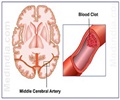New customized video game called myoelectric computer interface (MyoCI) helped retrain stroke survivors' arm muscles into moving more normally, finds a new study.

- Lab-based study lays groundwork for inexpensive, wearable therapy
- Only 30 percent of stroke survivors continue rehabilitation therapy after the first month due to cost, proximity to therapist
- Participants increased arm mobility, reduced arm stiffness
- Early version of device now being used at home by study patients
Most of the 32 study participants experienced increased arm mobility and reduced arm stiffness while they were using the training interface. Most participants retained their arm function a month after finishing the training.
Many stroke survivors can't extend their arm forward with a straight elbow because the muscles act against each other in abnormal ways, called "abnormal co-activation" or "abnormal coupling."
The Northwestern device identifies which muscles are abnormally coupled and retrains the muscles into moving normally by using their electrical muscle activity (called electromyogram, or EMG) to control a cursor in a customized video game. The more the muscles decouple, the higher the person's score. (More on how the device works below)
"We gamified the therapy into an '80s-style video game," said senior author Dr. Marc Slutzky, associate professor of neurology and physiology at Northwestern University Feinberg School of Medicine and a Northwestern Medicine neurologist. "It's rather basic graphics by today's standards, but it's entertaining enough."
Slutzky and his co-authors have paired with a company on an early version of a wearable device to study at-home use with patients. The device communicates wirelessly with a laptop or tablet, and the goal is to make this a completely wireless, wearable device.
Advertisement
"Long-term, I envision having flexible, fully wireless electrodes that an occupational therapist could quickly apply in their office, and patients could go home and train by themselves."
Advertisement
A NEW TYPE OF STROKE THERAPY:
Abnormal coupling of muscles leaves many stroke patients with a bent elbow, which makes it difficult to benefit from typical task-based stroke-rehabilitation therapies, such as training on bathing, getting dressed and eating.
Only about 30 percent of stroke patients in the United States receive therapy after their initial in-patient rehabilitation stay, often because their injury is too severe to benefit from standard therapy, it costs too much, or they're too far from a therapist. This small, preliminary study lays the groundwork for inexpensive, wearable, at-home therapy options for severely impaired stroke survivors.
"We're still in the very early stages, but I'm hopeful this may be an effective new type of stroke therapy," Slutzky said. "The goal is to one day let patients buy the training device inexpensively, potentially without even needing insurance and use it wirelessly in their home."
HOPE FOR SEVERELY IMPAIRED STROKE SURVIVORS:
Patients in the study were severely impaired - could only slightly move their arm and extend their elbow- and had had their stroke at least six months before beginning the study. The average patient was more than six years out from their stroke, and some were decades out.
After Slutzky's intervention, study participants could, on average, extend their elbow angle by 11 degrees more than before the intervention, which was a pleasant surprise, Slutzky said. "Classically, in patients that far out from a stroke, we don't typically expect to see any improvements, but we saw modest yet significant improvement in these patients," Slutzky said.
This type of treatment only requires a small amount of muscle activation, which is advantageous for severely impaired stroke patients who typically can't move enough even to begin standard physical therapy. It also gives feedback to the patient if they're activating their muscles properly.
"We learn how to move by trial and error," Slutzky said. "If you don't have any feedback about the errors, it's hard to learn to improve movement. This task provides patients with clear feedback about their muscle activation."
HOW THE DEVICE WORKS:
To identify which muscles were abnormally coupled, study participants attempted to reach out to multiple different targets while the scientists recorded the electrical activity in eight of their arm muscles using electrodes attached to the skin. For example, the biceps and anterior deltoid muscles in the arm often activated together in stroke participants, while they normally shouldn't.
Then, to retrain the muscles into moving normally (i.e., without abnormally co-activating), the participants used their electrical muscle activity to control a cursor in a customized video game. The two abnormally coupled muscles moved the cursor in either horizontal or vertical directions, in proportion to their EMG amplitude. For example, if the biceps would contract in isolation, the cursor would move up. If the anterior muscles would contract in isolation, the cursor would move to the side. But if the muscles would contract together, the cursor would move diagonally.
The goal was to move the cursor only vertically or horizontally - not diagonally - to acquire targets in the game. To get a high score, participants had to learn to decouple the abnormally coupled muscles.
Muscles tend to produce more electrical muscle activity when contracting isometrically (without moving) compared to when moving the arm freely, but the ultimate goal of this training is to enable home use. One goal of this study was to see if participants could benefit without restraining the arm as much as with restraining the arm.
Participants were broken into three groups: 60 minutes of training with their arm restrained; 90 minutes of training with their arm restrained; and 90 minutes of training without arm restraints. Overall, arm function improved substantially in all groups, and there was no significant difference between the three groups.
Source-Eurekalert















